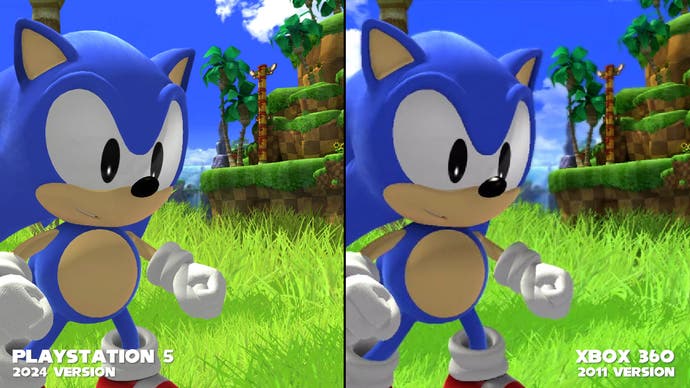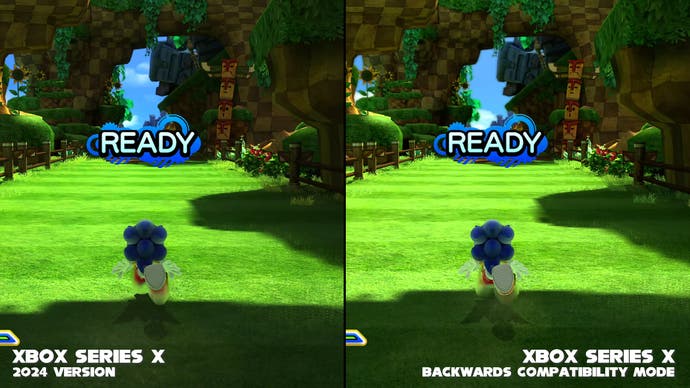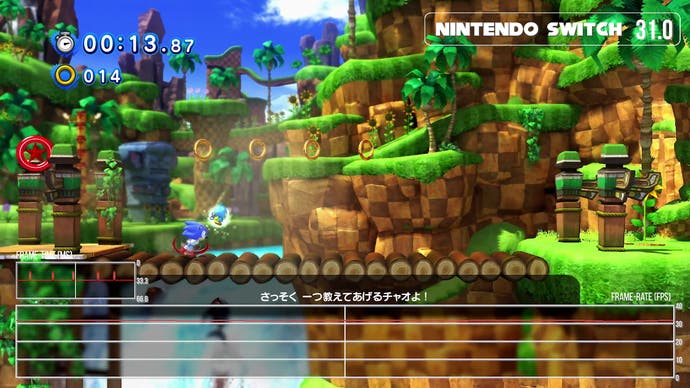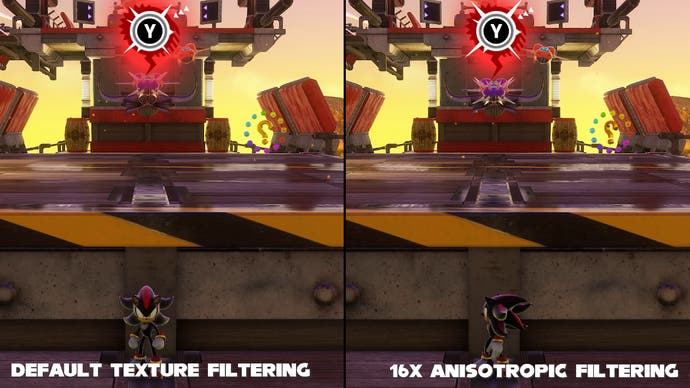
- Action Adventure
- Digital Foundry
- nintendo switch
- PC
- Platformer
- ps4
- ps5
- Sega
- Side view
- Single Player
- Sonic Team
- Sonic X Shadow Generations
- Third person
- xbox one
- Xbox Series X/S
Sonic x Shadow Generations tech review: great on PlayStation, Xbox and PC, but hamstrung on Switch
First released in 2011, Sonic Generations is one of the best efforts to bring the blue hedgehog into the third dimension. Building on the boost formula established in Sonic Unleashed, Generations sought to merge 2D and 3D gameplay into a cohesive whole, but Sega never directly followed up on it – until now. Sonic X Shadow Generations‘s initial reveal made it feel like a remaster with a little extra content bolted on, but this game also serves as a full-length sequel to Sonic Generations, built using the latest version of Hedgehog Engine and packed with incredible stages for all current and last-gen consoles, plus PC. Our tech review looks at that package as a whole, comparing it to the original Sonic Generations release, discussing performance and how the Switch version in particular fares.
In its original form, Sonic Generations released on Xbox 360 and PlayStation 3 running at 880×720 and 30fps, with a PC version following in its wake that brought the game to 60fps. A backwards compatible version for modern Xbox consoles – Xbox One and Series X/S – came out just a few years ago, with higher resolution visuals at 60fps. Now the 2024 release brings the game – and the all-new Shadow Generations content – to PS5, PS4 and PS4 Pro, Xbox Series X/S, Xbox One/X, Switch and PC.
Perhaps unsurprisingly given the difference in vintage, the main menu of Sonic x Shadow Generations lets you choose between Sonic Generations and Shadow Generations modes when you first start it up. Starting with Sonic’s game, the entire UI has been remade to support 4K, loads are super fast, a new profile system allows for multiple saves, and all pre-rendered cutscenes were recreated at 4K – a big improvement over the ugly 720p videos of the original. Sega has done a great job improving the visuals here.
Weirdly though, the game has been rewritten and voiced in English – something that only became apparent after I switched the game to Japanese and got completely different dialogue. That means mixing Japanese voices with English text, for example, would produce a mismatched result.
Beyond this though, I wanted to find out whether this new version of Generations overcomes the limitations of the original, or whether there are instances where you might prefer that original 2011 version.
If you’re on any of the PlayStation consoles, the new release is your only option – and thankfully, it’s good. PS4, PS4 Pro and PS5 all run at 60fps, with PS5 running at a clean native 4K but even PS4 still faring well – this is an excellent version of Sonic Generations. There are occasionally small frame-time hiccups on PS4, which is a little odd but doesn’t detract from the experience in a major way.
If you’re on Xbox, the recommendation is a little more complicated. If you’re using an Xbox One or One X, this new version is the way to go as it’s the only way to enjoy the game at 60fps. On Series consoles, however, the Xbox 360 version running in back-compat mode is also 60fps and in theory ought to offer a similar experience. Weirdly though, this 360 version doesn’t work on my Xbox Series X correctly right now, with stutters and skips in the gameplay and audio that weren’t there before and don’t appear in other back-compat games. I couldn’t fix this with a reboot or clearing quick resume data, so it’s a bit of a mystery.
There’s also the curious case of the Switch. Given that Generations is an Xbox 360 and PS3 game, I expected Nintendo’s handheld to ace this one, but the Sonic Generations port isn’t great. Image quality is fine, at 1080p, but the game runs at a super-weird 31.5fps. That means you get constant stutter on the Switch, making it look even worse than the Xbox 360 version at its locked 30fps!
The PC version is also tricky. The new Sonic Generations release is a separate application and, as in the console versions, doesn’t use the same updated tech as Shadow Generations. That means it by and large looks the same as the stock version, but doesn’t support mods at present. Unfortunately, it doesn’t play smoothly at a refresh rate of anything other than a 60Hz. I suspect there are similar underlying frame-rate cap versions as on the Switch release, so for now I recommend manually changing to 60Hz before starting the game.


So that’s the lay of the land as far as the original goes. The good news is that Sonic Generations itself is still an amazing experience and most of these new versions are good too. Honestly, the visuals haven’t been touched up and it’s wild to me that a 2011 game can look this good – it really shows how strong Sonic Team’s art direction was on this title, not to mention the benefits of Hedgehog Engine. Of course, this is still the Hedgehog Engine circa 2011, so shifting to Shadow Generations brings a hugely updated version of Sega’s in-house tech, making the new game the centrepiece of this collection.
Essentially, at its core, Shadow Generations follows a design similar to Sonic Generations, but with Shadow as the main character. The big differences lie in storytelling and progression. Basically, the story is told much more like the Sonic Adventure titles, with more dramatic cutscenes, while the progression evolves the white space concept from Generations into a fully 3D map inspired by Sonic Frontiers. The idea is that you move around in full 3D between stages, completing challenges to fill in the void. This is a smart change that leverages everything the team learned when building Sonic Frontiers, but in a more focused way.
The new levels are the highlight here, which are inspired by stages from prior Sonic titles – including Sonic Adventure 2, Heroes, 2006, Forces and even Frontiers. They’re all gorgeous, fast and beautifully designed. Compared to Generations, there is more of a cinematic flair, with some crazy camera work and slick sequences a-plenty. I love it.

These levels also benefit from that more modern Hedgehog Engine tech, and as such run with completely different settings and performance targets than Sonic Generations. PS5, Xbox Series X and even Xbox Series S offer performance and quality modes, with the 30fps quality mode being the default choice on Xbox. I’d recommend the 60fps performance mode instead, given the nature of the gameplay, some frame pacing issues, and the fact that the game still appears sharp enough at 60fps – though it is noticeably blurrier on Series S. Shadow Generations also features temporal anti-aliasing (TAA) and dynamic resolution scaling, topping out at around 1800p in performance mode at a stable 60 on the higher-end consoles.
Last-gen consoles are unfortunately limited to 30fps in Shadow Generations, though this makes sense given the leap in fidelity. The Switch version doesn’t exhibit the 31.5fps issue of Sonic Generations, but it does have severely unstable frame pacing that results in a sub-par experience, despite the relatively good image quality. Loading times are also significantly longer here than on the other current-gen consoles.
On the flip side, the PC version is excellent, as it offers support for 120fps and therefore feels significantly smoother than any other version, while increasing resolution up to native 4K. If you have the hardware, this is the way to go.


Honestly, there’s a huge amount of data to sift through when you break it down – nine unique versions each, with two very different games. If you include the performance mode options, that’s 22 permutations. What’s most important to know is that the PS5 and both Xbox Series consoles deliver a smooth 60fps across the board. The PC version is also very performant. Last-gen consoles are split between 60fps for Sonic Generations and 30fps for Shadow Generations, while Switch struggles across the whole package. It’s certainly an interesting situation.
The only other thing I wanted to mention about the visuals is that the game suffers from poor texture filtering – and this affects every version including PC, though on PC you can use your graphic card’s control panel to force a higher quality version.
Despite this complexity, the game within is well made and well worth playing. Shadow Generations is one the best 3D Sonic titles to date, thanks to Shadow’s uniquely responsive and immediate movement. This gives the game its own unique physics and other quirks, with some additional powers to keep things fresh. In typical Sonic fashion, the game also features an excellent soundtrack, with a huge selection of new arrangements, new songs and returning classics.
Ultimately, I’m really happy with this one – the game ended up being larger in scope than I expected and I love it. As Digital Foundry’s lone Sonic fan, I’m happy to say that Team Sonic has largely done a great job. It’s just a shame the Switch version is afflicted with its frame-rate challenges, a small stain on what is an otherwise triumphant multi-platform release.
fbq('init', '560747571485047');
fbq('track', 'PageView'); window.facebookPixelsDone = true;
window.dispatchEvent(new Event('BrockmanFacebookPixelsEnabled')); }
window.addEventListener('BrockmanTargetingCookiesAllowed', appendFacebookPixels);

